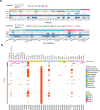Global Landscape of Clostridioides Difficile Phylogeography, Antibiotic Susceptibility, and Toxin Polymorphisms by Post-Hoc Whole-Genome Sequencing from the MODIFY I/II Studies
- PMID: 33751421
- PMCID: PMC8116447
- DOI: 10.1007/s40121-021-00426-6
Global Landscape of Clostridioides Difficile Phylogeography, Antibiotic Susceptibility, and Toxin Polymorphisms by Post-Hoc Whole-Genome Sequencing from the MODIFY I/II Studies
Abstract
Introduction: Clostridioides (Clostridium) difficile infection, the leading cause of healthcare-associated diarrhea, represents a significant burden on global healthcare systems. Despite being a global issue, information on C. difficile from a global perspective is lacking. The aim of this study is to model the global phylogeography of clinical C. difficile.
Methods: Using samples collected from the MODIFY I and II studies (NCT01241552, NCT01513239), we performed whole-genome sequencing of 1501 clinical isolates including 37 novel sequence types (STs), representing the largest worldwide collection to date.
Results: Our data showed ribotypes, multi-locus sequence typing clades, and whole-genome phylogeny were in good accordance. The clinical C. difficile genome was found to be more conserved than previously reported (61% core genes), and modest recombination rates of 1.4-5.0 were observed across clades. We observed a significant continent distribution preference among five C. difficile clades (Benjamini-Hochberg corrected Fisher's exact test P < 0.01); moreover, weak association between geographic and genetic distance among ribotypes suggested sources beyond healthcare-related transmission. Markedly different trends of antibiotic susceptibility among lineages and regions were identified, and three novel mutations (in pyridoxamine 5'-phosphate oxidase family protein: Tyr130Ser, Tyr130Cys, and a promoter SNP) associated with metronidazole-reduced susceptibility were discovered on a nim-related gene and its promotor by genome-wide association study. Toxin gene polymorphisms were shown to vary within and between prevalent ribotypes, and novel severe mutations were found on the tcdC toxin regulator protein.
Conclusion: Our systematic characterization of a global set of clinical trial C. difficile isolates from infected individuals demonstrated the complexity of the genetic makeup of this pathogenic organism. The geographic variability of clades, variability in toxin genes, and mutations associated with antibiotic susceptibility indicate a highly complex interaction of C. difficile between host and environment. This dataset will provide a useful resource for validation of findings and future research of C. difficile.
Keywords: Antibiotic susceptibility; CDI; Clostridioides (Clostridium) difficile; Evolution; Metronidazole; Moxifloxacin; Phylogeography; Rifaximin; Toxin; Vancomycin.
Figures





Similar articles
-
Evolutionary and Genomic Insights into Clostridioides difficile Sequence Type 11: a Diverse Zoonotic and Antimicrobial-Resistant Lineage of Global One Health Importance.mBio. 2019 Apr 16;10(2):e00446-19. doi: 10.1128/mBio.00446-19. mBio. 2019. PMID: 30992351 Free PMC article.
-
Prevalence and Strain Characterization of Clostridioides (Clostridium) difficile in Representative Regions of Germany, Ghana, Tanzania and Indonesia - A Comparative Multi-Center Cross-Sectional Study.Front Microbiol. 2018 Aug 7;9:1843. doi: 10.3389/fmicb.2018.01843. eCollection 2018. Front Microbiol. 2018. PMID: 30131799 Free PMC article.
-
Molecular epidemiology and antimicrobial susceptibility of Clostridium difficile isolated from hospitals during a 4-year period in China.J Med Microbiol. 2018 Jan;67(1):52-59. doi: 10.1099/jmm.0.000646. Epub 2017 Nov 21. J Med Microbiol. 2018. PMID: 29160203
-
Insights into the Evolving Epidemiology of Clostridioides difficile Infection and Treatment: A Global Perspective.Antibiotics (Basel). 2023 Jul 1;12(7):1141. doi: 10.3390/antibiotics12071141. Antibiotics (Basel). 2023. PMID: 37508237 Free PMC article. Review.
-
Genetic Mechanisms of Vancomycin Resistance in Clostridioides difficile: A Systematic Review.Antibiotics (Basel). 2022 Feb 16;11(2):258. doi: 10.3390/antibiotics11020258. Antibiotics (Basel). 2022. PMID: 35203860 Free PMC article. Review.
Cited by
-
Mechanisms and impact of antimicrobial resistance in Clostridioides difficile.Curr Opin Microbiol. 2022 Apr;66:63-72. doi: 10.1016/j.mib.2022.01.004. Epub 2022 Jan 22. Curr Opin Microbiol. 2022. PMID: 35077947 Free PMC article. Review.
-
Gut Microbiota and New Microbiome-Targeted Drugs for Clostridioides difficile Infections.Antibiotics (Basel). 2024 Oct 20;13(10):995. doi: 10.3390/antibiotics13100995. Antibiotics (Basel). 2024. PMID: 39452261 Free PMC article. Review.
-
Reduced Susceptibility to Metronidazole Is Associated With Initial Clinical Failure in Clostridioides difficile Infection.Open Forum Infect Dis. 2021 Jul 8;8(8):ofab365. doi: 10.1093/ofid/ofab365. eCollection 2021 Aug. Open Forum Infect Dis. 2021. PMID: 34381844 Free PMC article.
-
Decoding a cryptic mechanism of metronidazole resistance among globally disseminated fluoroquinolone-resistant Clostridioides difficile.Nat Commun. 2023 Jul 12;14(1):4130. doi: 10.1038/s41467-023-39429-x. Nat Commun. 2023. PMID: 37438331 Free PMC article.
-
Abundant geographical divergence of Clostridioides difficile infection in China: a prospective multicenter cross-sectional study.BMC Infect Dis. 2025 Feb 7;25(1):185. doi: 10.1186/s12879-025-10552-y. BMC Infect Dis. 2025. PMID: 39920584 Free PMC article.
References
Grants and funding
LinkOut - more resources
Full Text Sources
Other Literature Sources

